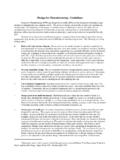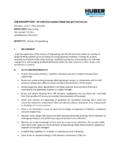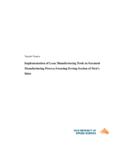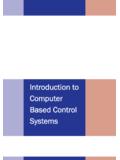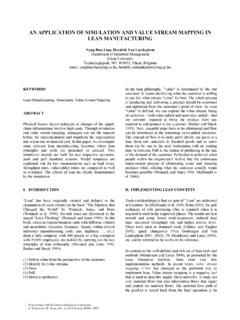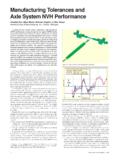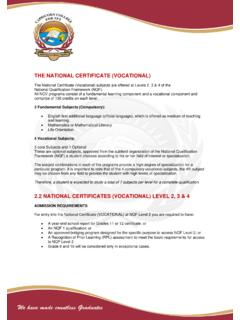Transcription of Paper - Value Stream Mapping of a Complete Product
1 Shahrukh A. Irani and Jin Zhou Value Stream Mapping of a Complete Product Shahrukh A. Irani and Jin Zhou Department of Industrial, Welding and Systems Engineering The Ohio State University Columbus, OH 43210 Introduction Lean Thinking, a concept that is based on the Toyota Production System, extends continuous improvement efforts to reduce the costs of serving customer/s beyond the physical boundaries of a manufacturing facility, by including the suppliers, distributors and production system that support the manufacturing function [Womack and Jones, 1996]. These improvements and cost reductions are achieved by eliminating the muda (wastes) associated with all activities performed to deliver an order to a customer.
2 Wastes are defined as all activities that consume resources (add costs to the Product ) but contribute zero Value to the customer. According to Womack and Jones, there are five steps for implementing Lean Thinking in an enterprise: 1) Define Value from the perspective of the Customer, 2) Identify the Value Streams, 3) Achieve Flow, 4) Schedule production using Pull, and 5) Seek Perfection through Continuous Improvement. Womack and Jones define a Value Stream as the set of all the specific actions required to bring a specific Product through the three critical management tasks of any business: ..problem solving, ..information management, ..physical transformation.
3 Alternatively, Rother and Shook define a Value Stream as all the actions (both Value -added and non- Value -added) currently required to bring a Product through the main flows essential to every Product [Rother and Shook, 1999, p. 3]. Overview of Value Stream Mapping Value Stream Mapping (VSM) is the process of Mapping the material and information flows required to coordinate the activities performed by manufacturers, suppliers and distributors to deliver products to customers. Unlike the traditional process Mapping tools used by IE s, VSM is a Mapping tool that maps not only material flows but also information flows that signal and control the material flows.
4 This enhanced visual representation facilitates the identification of the Value -adding steps in a Value Stream and elimination of the non- Value adding steps, or wastes (muda). Using VSM, many OEM s and their top-tier suppliers have changed their existing facility layouts, as well as existing systems for material handling, inventory control, purchasing and scheduling, to reduce the total throughput times of orders and current levels of work-in-process (WIP) inventories. A typical VSM project involves the development of maps: (1) a Current State Map and (2) one or more Future State Maps that represent progressive improvements in the Current State Map.
5 In the Current State Map, one would normally start by Mapping a Product family that accounts for a significant proportion of the total annual production volume and sales earnings (or even profit margin) of the company. Usually, the material Shahrukh A. Irani and Jin Zhou flow is mapped on an 11 X 17 sheet of Paper using appropriate icons. The (material) flow of the Product is traced back from the final operation in its routing to the storage location for raw material. Relevant data for each operation, such as the current schedule (push, pull, and order dispatching rules in effect at any process ex. FIFO) and the amount of inventory in various queues, is recorded on the map.
6 The information flows are also incorporated to provide demand information, which is an essential parameter for determining the pacemaker process in the manufacturing system for which the Current State Map is being developed. After both material and information flows have been mapped, a time-line is displayed at the bottom of the map showing the processing time for each operation and the transfer delays between operations. The time-line is used to identify the Value -adding steps, as well as wastes, in the current system. A comparison of the processing times and the takt time (calculated as Available Capacity/Customer Demand) serves as a preliminary measure of the Value and wastes in the current system.
7 This takt time is mostly used as an ideal production rate for each operation to achieve. Ideally, the cycle time for each operation in a Value Stream should be less than or equal to the takt time. Based on the Current State Map, a Future State Map is generated for improving the Value -adding steps and eliminating the non- Value adding steps (waste) in the current system. Based on the concepts of Lean Thinking, Rother & Shook provide seven guidelines to follow when generating the Future State Map for an improved manufacturing system (Rother and Shook, 1999, p. 44-54): 1. Produce to takt time 2. Develop continuous flow 3. Use supermarkets to control production where continuous flow does not extend upstream 4.
8 Schedule based on the pacemaker operation 5. Produce different products at a uniform rate (Level the production mix) 6. Level the production load on the pacemaker process (Level the production volume) 7. Develop the capability to make every part every (EPE) <time period> Pros of Value Stream Mapping : An Industrial Engineering Viewpoint Relates the manufacturing process to supply chains, distribution channels and information flows. Integrates material and information flows. Links Production Control and Scheduling (PCS) functions such as Production Planning and Demand Forecasting to Production Scheduling and Shopfloor Control using operating parameters for the manufacturing system ex.
9 Takt time which determines the production rate at which each processing stage in the manufacturing system should operate. Shahrukh A. Irani and Jin Zhou Helps to unify several IE techniques for material flow analysis, such as Production Flow Analysis (PFA), Business Process Reengineering (BPR), and Process Analysis and Improvement (PA&I) that, to date, have been taught and implemented in isolation. Provides important descriptive information for the Operation and Storage icons in the standard Flow Process Charts used by IE s. Forms the basis for implementation of Lean Manufacturing by designing a manufacturing system based on the Complete dock-to-dock flow time for a Product family.
10 Provides a company with a blueprint for strategic planning to deploy the principles of Lean Thinking to facilitate their transformation into a Lean Enterprise. Cons of Value Stream Mapping : An Industrial Engineering Viewpoint Fails to map multiple products that do not have identical manufacturing routings or assembly process flows. Fails to relate Transportation and Queuing delays, and changes in transfer batch sizes due to poor plant layout and/or material handling, to operating parameters (ex. machine cycle times) and measures of performance (ex. takt time)1 of the manufacturing system. Lacks an economic measure for Value , such as profit, throughput, operating costs, inventory expenses, etc.
